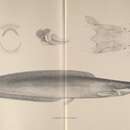Diagnostic Description
provided by Fishbase
Diagnosis: 16-50 gill rakers on first gill arch (much more reduced compared to Clarias gariepinus)(Ref. 57129, 81644), subject to geographical variations (Ref. 57129). Head oval-shaped to rectangular in dorsal outline; snout broadly rounded; eyes rather lateral in position and, together with relatively broad head, make for a relatively large interorbital distance; number of gill rakers on first branchial arch subject to much variation, 16-40, rarely exceeding 40; dorsal fin base situated close to occipital process; dorsal fin always terminates before caudal fin base, distance between both small; anal fin originates closer to caudal fin base than to tip of snout, nearly reaching caudal fin but never confluent; pelvic fin base slightly closer to tip of snout than to caudal fin base, reaching base of first anal fin rays; pectoral fin extend from operculum to base of first dorsal fin rays (Ref. 248). Pectoral spine slightly curved and robust (Ref. 248), serrated only on its outer side (Ref. 248, 81644), number of serrations increases with increasing standard length (Ref. 248). Lateral line appears as a small, white line running from posterior end of head to middle of caudal fin base (Ref. 248). Openings of secondary sensory canals (flank neuromasts) clearly marked, showing a regular pattern (Ref. 248, 81644).Description: number of gill rakers on first gill arch is subject to geographical variations, i.e., from 16 (specimen of 62mm SL) to 27 (specimen of 541mm SL) in the Chad basin, from 18 (83mm SL) to 37 (309mm SL) in coastal basins of Togo, in the Volta, coastal basins of Côte dâIvoire and Gambia, as well as in the River Senegal, up to 40 in Mauritania, and 50 in the artificial lakes Kossou (Côte dâIvoire) and Nungua (Ghana)(Ref. 57129).Coloration: 2 colour patterns can be discerned: the uniform and the marbled pattern (Ref. 248). In uniform pattern, specimens are uniform dark-brown, blackish brown or reddish brown on dorsal side and on flanks as well as on upper surface of paired fins, belly and lower surface of paired fins light brownish to beige (Ref. 248). In marbled pattern, back and flanks show irregular dark blotches on a light coloured background, belly and ventral parts of paired fins whitish (Ref. 248). Most specimens with pigmentation bands on both sides of lower surface of head; a series of light and dark bands may occur on caudal fin, proximal third of fin lightly coloured, while rest is darkly coloured; occasionally, irregular black spots occur on caudal fin and caudal peduncle (Ref. 248).
- Recorder
- Crispina B. Binohlan
Life Cycle
provided by Fishbase
Breeding season varies among localities, apparently timed to the rainy season.
- Recorder
- Crispina B. Binohlan
Migration
provided by Fishbase
Potamodromous. Migrating within streams, migratory in rivers, e.g. Saliminus, Moxostoma, Labeo. Migrations should be cyclical and predictable and cover more than 100 km.
Morphology
provided by Fishbase
Dorsal spines (total): 0; Dorsal soft rays (total): 60 - 82; Analsoft rays: 42 - 61
- Recorder
- Crispina B. Binohlan
Trophic Strategy
provided by Fishbase
Feeds on detritus, fish, benthic organisms and plants (Ref. 6186).
- Recorder
- Crispina B. Binohlan
Biology
provided by Fishbase
Very common in inundated areas. Bury themselves in the mud when the pools are drying up. Feed mainly on fish and mollusks; also crustaceans, diatoms, detritus and bottom organisms (Ref. 248). Omnivorous and reproduction takes place in the rainy saison (Ref. 78218). Max. size for West Africa and Lower Guinea: 650mm TL (Ref. 57129, 81644).
Importance
provided by Fishbase
fisheries: minor commercial; aquaculture: commercial
Clarias anguillaris: Brief Summary
provided by wikipedia EN
Clarias anguillaris is a species of African airbreathing catfish also known as the mudfish. This species is of minor importance in commercial fisheries. It grows to a length of 100 cm (39.4 inches) TL.

Clarias anguillaris


- license
- cc-by-sa-3.0
- copyright
- Wikipedia authors and editors




